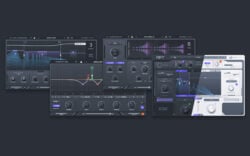The Dada Life Sausage Fattener might look deceivingly simple at first glance, but once acquainted with its functionality it has the ability to put your tracks in to high gear. It’s used by countless top notch producers such as Tiësto, Zedd, and Diplo, and for good reason – it packs a serious punch that can add impact and power to your tracks. It is also currently the 5th most-used plugin by producers on Splice! Here we’ll explore what the Sausage Fattener is all about and some of the ways you can use it in your own productions.
The GUI is fairly straightforward; you’re presented with three knobs: FATNESS, COLOR, and GAIN. As you start to adjust these knobs, several things begin to happen simultaneously. The FATNESS knob boosts the initial signal by as much as 30dB while at the same time adding complex saturation, which is subtle distortion caused by introducing upper harmonics to the fundamental tone. The COLOR knob adjusts the harmonic relationships within the saturation algorithm. By adjusting the COLOR knob and increasing its value, you begin to increase the amplitude or volume of the uppermost harmonics, which causes the timbre to become brighter. A high degree of saturation can quickly cause the original signal to become rather unwieldy, so thankfully the Dada Life Sausage Fattener provides you with a GAIN knob to adjust the overall volume of the signal as well as a CLIPPING INDICATOR to further keep the levels in check.
To illustrate this process, we’ll take a simple sine wave at 261Hz, which corresponds to middle C on the piano keyboard, and slowly increase the value of the FATNESS knob until it has reached its maximum. At maximum value we have reached full saturation. As seen below, there are a multitude of upper harmonic overtones that are added to the fundamental tone within the harmonic spectrum that add character to the original timbre.
Now that we’ve explored some of the inner workings of this plugin, let’s dive right in and take a look at some specific examples that you can apply to your own projects.
Saturation in the context of a track can be useful in several ways. The obvious use is to make the primary voice of your track as big as possible so that it truly stands out and has the most impact and presence for the listener. This applies most readily to bass lines and lead lines. In the example below, we have an electro bass line that is a bit dull and unsatisfying. By introducing the Sausage Fattener at the drop as an insert effect, with a FATNESS value of 55% and a COLOR value of 20%, we can immediately hear that the bass timbre becomes richer and more exciting. It’s apparently louder in the mix, despite the fact that more mix elements have entered and that it’s actually metering at 5dB below the dry signal before the drop. It’s important to level match the volume of the dry and wet signal while making comparisons so that you get an accurate aural picture of the differences – it’s human nature that louder signals will sound better at first listen, but that’s not always the case. Use the GAIN knob while auditioning your settings to level match and get a clearer sense of the harmonic differences. A little FATNESS can go a long way!

Another more subtle use of saturation is when used as a mixing technique. It might seem counterintuitive at first, but the Dada Life Sausage Fattener can actually be used to subtly tame signals as well as accentuate them. This is best exemplified in the case of using 808 bass sounds that need to have plenty of implied bass but don’t necessarily need to consume the entire mix, which might lead to loss of clarity in the upper registers and detract from the overall energy or loudness of the mix. This has become increasingly important for engineers as more and more listeners are enjoying music on ear buds or laptop speakers that are unable to accurately reproduce audio signals in lower registers.
In the example below, we’ve taken an overly bass heavy 808 and added the Sausage Fattener as an insert effect with a FATNESS value of 90% and a COLOR value of 35%. We then diminished the amplitude of the fundamental frequency of the 808 using equalization. The human brain has the capacity to extrapolate the implied fundamental frequency even though it’s been diminished in volume. By using the Sausage Fattener’s saturation to accentuate the upper harmonic spectrum of the 808, you can allow other elements in the mix more space to breathe, while increasing the amount of total available headroom when aiming for optimum overall loudness in the final mix.
Sausage Fattener will sound fantastic on your master channel as well. In this example, we’ve inserted the Sausage Fattener as the very last device in our mastering chain with a FATNESS value of just 8% and a COLOR value of just 10%. We activate the module halfway through the example to give you a sense of the subtle yet extremely effective saturation and loudness characteristics that Sausage Fattener has to contribute to your master.
The Dada Life Sausage Fattener’s unique blend of simplicity and sonic quality has made it a favorite among novice producers and seasoned professionals alike.
Sausage Fattener is available in AU and VST formats for both 32-bit and 64-bit platforms.
You can purchase the Sausage Fattener at Dada Life’s website here.
Download top samples and presets each month
Start browsing and find the sound that will inspire your next track.
Explore royalty-free one-shots, loops, FX, MIDI, and presets from leading artists, producers, and sound designers:
July 8, 2014

.svg)
.svg)








